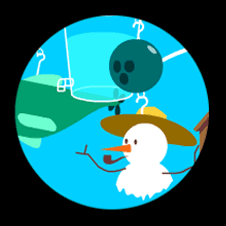Alright. Been reading
HobbyPrincess (the blog by
Ms. Mutanen, one of the creators of
ThingLink, a design student at the
U of Helsinki). There's a
very good bit there about the kinds of experiences we have in museums. What kinds of experiences are preferable for the audience, artists, curators? We can "consume" the exhibitions in a simple, reactive way, or we can consume in a proactive way. Reactive consumption, as she puts it, consists of just showing up, buying a ticket, maybe reading the blurbs beside the art, moving on. Proactive consumption, on the other hand, can lead to productions of our own -- metabolizing the art, and creating text or images or conversations of our own about what we've experienced. We can share these creations privately, or make them public (and we can make them public in a very, very wide variety of ways now).
I love it when I come across a library that encourages proactive consumption of materials and exhibits. Seems like this rarely happens outside the children's collection, unfortunately. Strictly business for the grownups, please.
Some of the notions floating around in the library world now about folksonomic tags in catalog records fit into a proactive consumption model. I'd like to push this further. I'd like to find ways to give patrons open fields (not just in the catalog, not just (or necessarily) literally) to play with the info-objects in their collections. We have to be stewards of the collection, but what new ways might we open up our own "exhibitions" and "collections" to allow patrons a way to play and participate? If such play lead to a proactive consumption of library materials, spurring conversation in other places, this would be taking the library into the coffee shops and bars and galleries across town -- this would be a sexing-up of the library, if you will. And that would be very, very good.
As
I've written before, the info-techno-gizmo-junkie side of Web 2.0 doesn't excite me nearly as much as the attitudes it represents -- user-centered, customizable, participatory, response-oriented information spaces. Libraries don't even need computers to become 2.0 -- libraries need only start thinking of their collections and their patrons as part of a continuum of open participation. This is a self-reflexive, psyche-writ-large-within-four-walls-and-taking-it-to-the-streets library. This is a library in which the stakes are higher for everyone.
Encouraging collective, open participation, feedback, commentary and criticism about our policies and collections and administration -- this means that the stakes are higher because we have to answer to our critics and to proponents of new ideas that require more hard work from us. The stakes are higher for the patrons, too, because to participate means to have your name tied to an idea, a comment, a creative act. We up the ante for our users when we let them have louder voices; suddenly more people are listening and responding critically to what their peers have said.
Can we do this without sacrificing our inherent conservatism? Can we maintain the integrity of our records and collections if we open ourselves up to participatory, proactive consumption?




